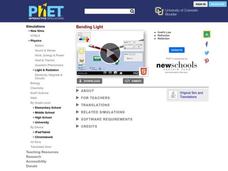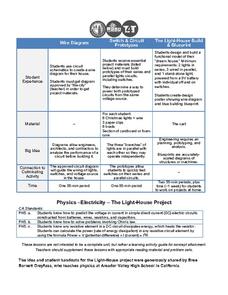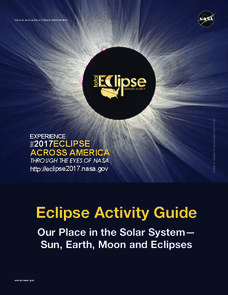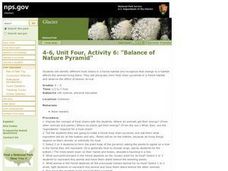PHET
Bending Light
Different colors of the spectrum travel at different speeds through media, causing them to refract at different angles—which allows humans to see their colors. Through a simulation, pupils see how air, water, and other media bend light....
Curated OER
Shadows & Light, Science & Puppetry
Lights, shadows, action, and inquiry await your artistic scientists. They explore the way light travels, absorbs, reflects, and transmits through shadow play. They create folktale-inspired shadow puppets, explore the science of light,...
Trash For Teaching
The Light-House Project
Groups work together to design a lighthouse, from designing and drawing the wiring diagram, to creating prototypes of the switch and circuit, to envisioning and building a scale model along with a blueprint. By including different...
Columbus City Schools
It’s Electric!
Shocking! Who knew so many great ideas existed for teaching middle schoolers about electricity? Find them all within this energetic framework. You'll light up at the variety of printable and web-based resources within! After building...
Curated OER
Science and Art Museum
Imagine each one of your learners on task and interested in scientific material. Learners investigate science related art by creating a small museum! Using digital cameras, pupils photograph different scientific actions that look...
NASA
Discovering Some of Your “Yardsticks” Are Actually “Meter-sticks”
The Milky Way gets great reviews on Trip Advisor — 100 million stars. The activity allows scholars to rethink their assumptions and prior knowledge. Pupils observe a set of two lights at equal distance and brightness, but they believe...
NASA
Eclipse Activity Guide
Ever made solar s'mores? Or recreated the solar system using peanuts? Astronomers young and old investigate all things solar using a variety of activities. Explore how the sun works, types of light it emits, and methods of charting the...
PHET
Wave Interference
Why did the waves get into a fight? They were tired of each other's interference. Scholars observe the wave patterns from dripping water, sound waves, and light waves. They vary the spacing, build barriers, and increase the number...
PHET
Band Structure
Electricity travels at the speed of light, 186,000 miles per second. Through a simulation, classes see how the structure of energy bands in crystals of atoms determines how materials conduct electricity. Participants can change the...
Curated OER
Energy Detectives at Work
Students are "Energy Detectives" working for an engineering firm that does energy evaluations at schools. In teams, they locate energy sources around the school, and record their findings on an Energy Detective Worksheet.
Curated OER
Greenhouse in a Bottle
Young atmospheric scientists create models of an atmosphere with and without clouds to determine the effect of cloud cover on Earth's temperatures, as well as figuring out whether dark or light surfaces absorb more energy. You may wish...
Curated OER
Designing an Ecologically Sound City
Fifth graders design an "ecologically sound" city. They write laws for the city to help make all citizens aware of their ecological responsibilities and propose alternative power sources for light and heat.
Curated OER
Lighten Up!
Third graders observe light as a form of energy, that it can be reflected/bounced, refracted/bent and absorbed. They explore how different types of light affect our lives as a whole. Songs are researched that involve light (ex. "You...
Curated OER
The Great Energy Debate
Students explore the controversial issues surrounding the energy debate in Canada. They research recent initiatives being taken in this area and analyze their implication. Students then assume the roles of pivotal stakeholders in this...
Curated OER
Hello, Sunshine!
Students investigate how the sun travels across the sky at different latitudes using Solar Motion Demonstrator. In this earth science instructional activity, students explain why seasons change. They study how the tilt of the Earth's...
Science 4 Inquiry
Phases of the Moon
The moon takes just over 27 days to orbit around Earth. Young scientists position themselves as the earth as they rotate around the sun and hold the moon. This allows them to observe the patterns and phases of the moon.
Curated OER
Invisible Rays
Students explore physical science by completing a lab assignment. In this sunlight lesson, students define a list of scientific vocabulary terms and complete fill in the blank questions. Students conduct a photographic experiment in...
Curated OER
Plate Tectonics: An "Eggs"periment
Learners investigate plate tectonics by observing a cracked egg shell. In this Earth science lesson, students draw borders of continents on an egg shell, only to watch it crack in a glass. Learners record the breakup of the...
Curated OER
Balance of Nature Pyramid
Students study the concept of food chains and create a physical forest food chain pyramid. In this balance of nature pyramid instructional activity, students identify the ingredients needed on each level of the pyramid then make...
Curated OER
Minimize the Effects of Fire
Students explore environmental safety by reading assigned text in class. In this fires lesson, students discuss the benefits and negative aspects of lighting a fire near a campground. Students list other ways to avoid leaving an impact...
California Academy of Science
Pollution in Our Watershed
The concept of a how pesticides and other chemicals pass through a watershed can be difficult for younger learners to grasp without a concrete example. In the activity here, some blank paper, markers, and a spray bottle are all you need...
Wild BC
Greenhouse Gas Guzzlers
Teams of six to eight players imagine that they are driving in a vehicle and collect balls that represent carbon dioxide emissions based on their different activities. "Greenhouse Gas Guzzler" cards tell teams how many balls to collect...
Curated OER
Life Unplugged
Students explore renewable and non-renewable energy sources, discuss how each source was created, and identify and sketch out the cycle of energy for each renewable source.
Curated OER
Astronomy and Me: Moons Over New Haven
Third graders study the features of different moons orbiting the planets. In this astronomy lesson, 3rd graders explore the different phases of the moon using an interactive online website. They compare and contrast the features of the...























